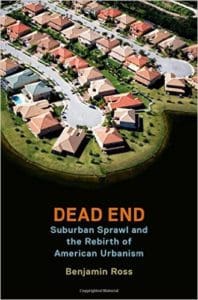 BOOK REVIEW | Dead End: Suburban Sprawl and the Rebirth of American Urbanism by Benjamin Ross
BOOK REVIEW | Dead End: Suburban Sprawl and the Rebirth of American Urbanism by Benjamin Ross
Review by Dr. Mark David Major, AICP, CNU-A, The Outlaw Urbanist contributor
The first half of Benjamin Ross’ Dead End: Suburban Sprawl and the Rebirth of American Urbanism (2014, Oxford University Press) is a majestic masterpiece of objective, clear, and concise diagnosis about the political, economic, and social origins of suburban sprawl in the United States with particular emphasis on the legal and regulatory pillars (restrictive covenants and exclusionary zoning ) perpetuating suburban sprawl to this day. It is required reading for anyone interested in the seemingly intractable problems of suburban sprawl we face today in building a more sustainable future for our cities. Chapters 1-10 (first 138 pages) of Dead End: Suburban Sprawl and the Rebirth of American Urbanism warrants a five-star plus rating alone.
However, Ross’ book becomes more problematic with the transition from diagnosis to prescription, beginning with an abrupt change in tone in Chapter 11. This chapter titled “Backlash from the Right” is, in particular, so politically strident that it reads as if the staff of Harry Reid’s Senate office wrote the text (the political left’s favorite boogeymen, the Koch Brothers, are even mentioned); or perhaps, the text of this chapter sprouted wholesale like Athena from the “vast right wing conspiracy” imaginings of Hillary Clinton’s head. This is unfortunate. In the second half of the book, Ross starts to squander most – if not all – of the trust he earned with readers during the exemplary first half of the book. It is doubly unfortunate because: first, it is done solely in the service of political dogma as Ross unconvincingly attempts to co-opt Smart Growth as a wedge issue for the political left in the United States; and second, it unnecessarily alienates ‘natural’ allies on the conservative and libertarian right sympathetic to Ross’ arguments for strong cities and good urbanism.
In the process, Ross tends to ignore or paper over blatant contradictions littering the philosophy of the political left in the United States when it comes to cities. Of course, this is a common Baby Boomer leftist tactic of absolving their generation for the collective disaster they’ve helped to create over the last half-century by confusing ideology for argument (and hoping no one will notice there’s a difference). For example, if you want to see what the policies of the political left look like after three-quarters of a century of dominance, then look no further than East St. Louis, Illinois. What has happened to that once vibrant city is absolutely criminal; literally so since several state and city Democratic officials and staffers have been sent to jail for corruption for decades.
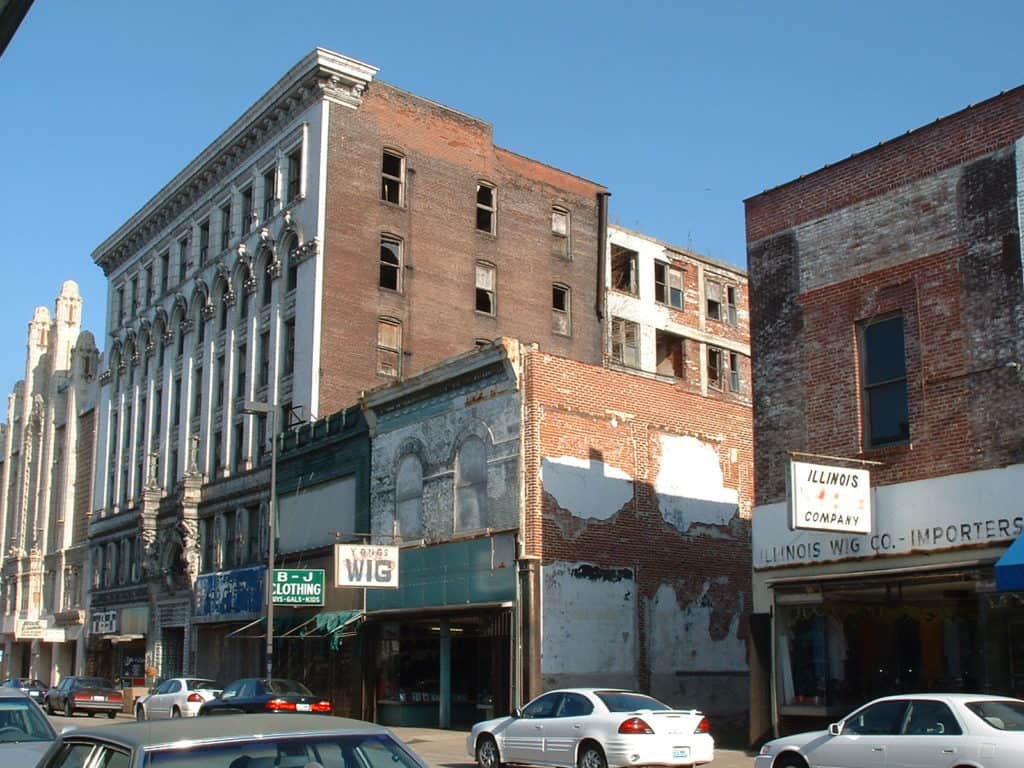 During the second half of Dead End: Suburban Sprawl and the Rebirth of American Urbanism, Ross also promotes the classic Smart Growth fallacy that public rail transit is the ‘magic bullet’ for reviving our cities. Indeed, public rail transit is important but too often Ross – like many others – comes across as unconsciously applying Harris and Ullman’s multi-nuclei model of city growth, which conveniently holds almost any function (in this case, rail stations/lines) can be randomly inserted almost anywhere in the fabric of a city without repercussions as long as land uses are ‘compatible.’ Of course, this is the ex post facto theoretical underpinning for the very ideas of Euclidean zoning and the common umbrella providing regulatory cover for all sorts of disastrous decisions in the name of “economic development.”
During the second half of Dead End: Suburban Sprawl and the Rebirth of American Urbanism, Ross also promotes the classic Smart Growth fallacy that public rail transit is the ‘magic bullet’ for reviving our cities. Indeed, public rail transit is important but too often Ross – like many others – comes across as unconsciously applying Harris and Ullman’s multi-nuclei model of city growth, which conveniently holds almost any function (in this case, rail stations/lines) can be randomly inserted almost anywhere in the fabric of a city without repercussions as long as land uses are ‘compatible.’ Of course, this is the ex post facto theoretical underpinning for the very ideas of Euclidean zoning and the common umbrella providing regulatory cover for all sorts of disastrous decisions in the name of “economic development.”
This is a potentially dangerous self-delusion shared by many in the Smart Growth movement. For example, what Ross attributes as the cause for the failure of some rail stations (lack of walkable, urban development around these stations due to the over-provision of space for ‘park and ride’ lots in catering to the automobile) is often really a symptom. The real disease is these stations were put in the wrong location in the first place due to local opposition, regulatory convenience, and/or political cowardice (i.e. that’s where the land was available). There is an inherent danger in approaching pubic rail transit as a cure-all panacea for the city’s problems. If our leaders, planners, and engineers take shortcuts in the planning, design, and locating of rail lines/stations, then we leave the fate of our cities to happenstance. It is far too important of an issue to approach in such a cavalier manner, as some Smart Growth advocates appear so inclined.
In a general sense, this is not really different from the arguments made in Dead End but, specifically, it is an important distinction that is glossed over or not properly understood when drilling down into the crucial details of Ross’ prescriptions. That being said, there are some interesting tidbits and ideas in the ‘prescription phase’ of Dead End: Suburban Sprawl and the Rebirth of American Urbanism. However, the reader has to be extremely careful about filtering out Ross’ political agenda from the more important morsels. For example, Ross correctly points out Americans’ disdain for buses is rooted in social status. However, he fails to point out – or perhaps even realize – that this peculiar American attitude is indoctrinated from childhood due to the expansive busing of kids to school in the United States (e.g.. only the poor and unpopular kids take the bus). In order to change this attitude, you have to radically change public education policies, something contrary to the invested interests of the political left. In fact, Ross has very little to say about schools, which seems like an odd oversight.
Too often, Ross’s prescription for building coalitions comes across as the same, old political activism of the counter-culture Baby Boomers that doesn’t really rise above the level of gathering everyone around the campfire and singing “Kumbaya, My Lord” (absent the “My Lord” part in the interests of political correctness). In the end, this suggests Ross has a well-grounded understanding about the historical, political and social impact of legal and regulatory instruments at work in our cities (exemplified by the first half of this book) but only a superficial idea about the design and function of cities and movement networks (including streets and rail) as witnessed by the lackluster second half, which is barely worth a two-star rating. Because of these strengths and weaknesses, Dead End: Suburban Sprawl and the Rebirth of American Urbanism is a four-star book in its entirety but you might be better served by reading the first half of the book, ignoring the second half, and having the courage to chart your own path in the fight for better cities.

 Dead End: Suburban Sprawl and the Rebirth of American Urbanism
Dead End: Suburban Sprawl and the Rebirth of American Urbanism
by Benjamin Ross
Hardcover, English, 256 pages
New York: Oxford University Press (May 2, 2014)
ISBN-10: 0199360146
ISBN-13: 978-0199360147
Available for purchase from Amazon here.


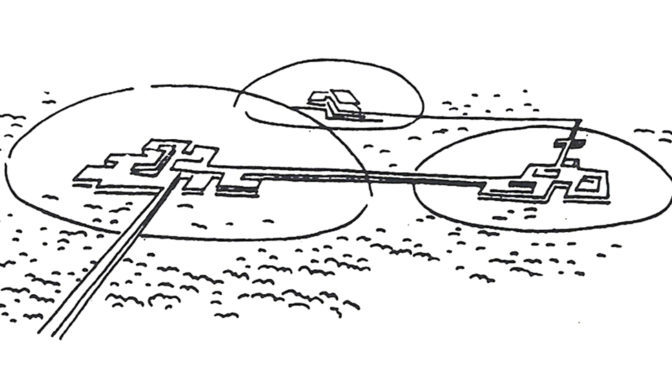
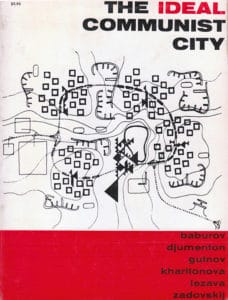
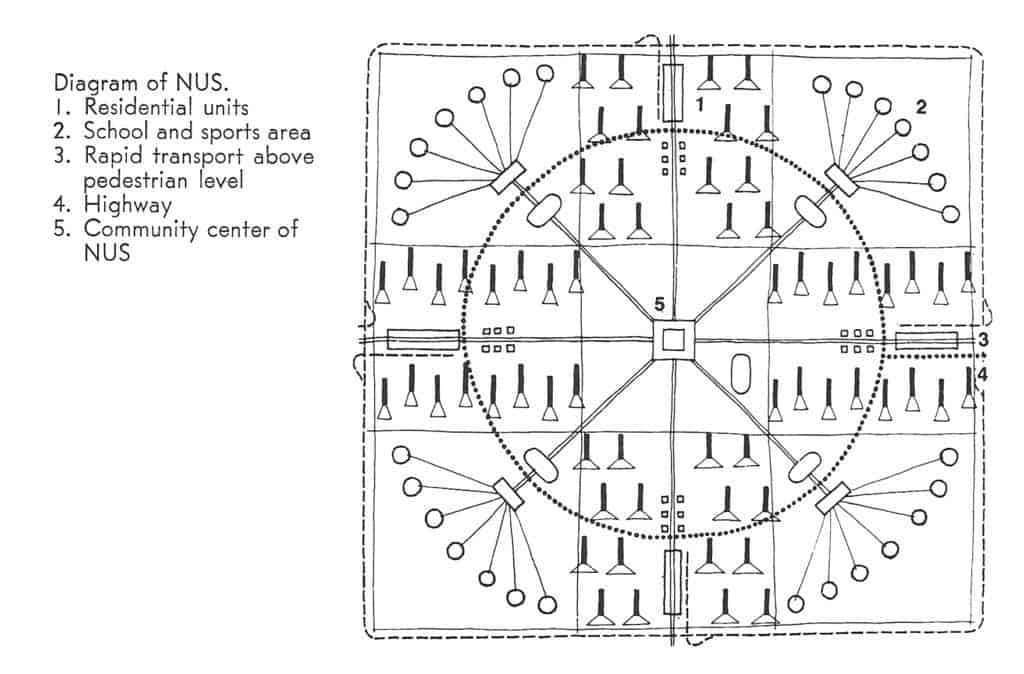 Of course, the key difference is the authors’ explicitly state the failure of these ideas to “reach their full potential” in Western societies is due to the corrupting influence of capitalism as a political and economic system. This is a conceit that has been badly exposed with time. If anything, capitalism more ruthlessly exploited the economic potentials of Modern ideas by taking them to their logical and, ultimately, extreme conclusion; probably more so than even most devoted CIAM architect ever imagined. The real danger about The Ideal Communist City is that younger readers (Millennials and generations thereafter) without any first-hand experience of the Cold War might make the mistake of thinking they are reading something original and entirely different because it’s wearing Soviet-era clothing. However, it is the same, tired planning paradigm we have been hearing about and (unfortunately) living with over the last 80+ years. To be fair, another key difference in this book is the desire of Soviet-era planners to adopt a model that segregates land uses from one another while still actively promoting manufacturing, mass production, and industrialization. Younger readers might also think this represents a somewhat unique perspective from the point of view of architecture and planning. However, it is really only evidence of Soviet preoccupation – even obsession – with Western societies’ manufacturing prowess at the time. In this sense, Soviet failure to compete with the success of Western capitalistic societies contradicted the ‘means of production’ arguments underpinning Karl Marx and Frederick Engel’s The Communist Manifesto and Marx’s Das Capital; that is, direct evidence that communism was a flawed political and economic system based on totalitarianism masquerading as a false ideology
Of course, the key difference is the authors’ explicitly state the failure of these ideas to “reach their full potential” in Western societies is due to the corrupting influence of capitalism as a political and economic system. This is a conceit that has been badly exposed with time. If anything, capitalism more ruthlessly exploited the economic potentials of Modern ideas by taking them to their logical and, ultimately, extreme conclusion; probably more so than even most devoted CIAM architect ever imagined. The real danger about The Ideal Communist City is that younger readers (Millennials and generations thereafter) without any first-hand experience of the Cold War might make the mistake of thinking they are reading something original and entirely different because it’s wearing Soviet-era clothing. However, it is the same, tired planning paradigm we have been hearing about and (unfortunately) living with over the last 80+ years. To be fair, another key difference in this book is the desire of Soviet-era planners to adopt a model that segregates land uses from one another while still actively promoting manufacturing, mass production, and industrialization. Younger readers might also think this represents a somewhat unique perspective from the point of view of architecture and planning. However, it is really only evidence of Soviet preoccupation – even obsession – with Western societies’ manufacturing prowess at the time. In this sense, Soviet failure to compete with the success of Western capitalistic societies contradicted the ‘means of production’ arguments underpinning Karl Marx and Frederick Engel’s The Communist Manifesto and Marx’s Das Capital; that is, direct evidence that communism was a flawed political and economic system based on totalitarianism masquerading as a false ideology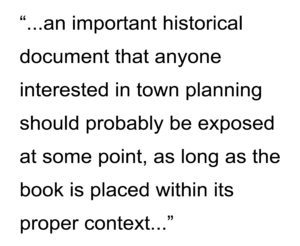 Having said all that, The Ideal Communist City is an important historical document that anyone interested in town planning should probably be exposed at some point, as long as the book is placed within its proper context for readers, especially post-Cold War ones. There are, in fact, relatively few flights of fancy in this book; the most amusing one being the common idea in science fiction that cities will eventually be covered by climate-controlled plastic domes (see Featured Image of this post at the top). The authors’ statistical projections of urban populations are way off, hilariously so. Early in the book, the authors project that 75% of the world’s population will live in urban areas by the year 2000 when it fact we only passed the 50% threshold in the last decade (due to the corrupting influence of capitalism, no doubt). The model of the NUS stretches believability despite the authors’ best – though somewhat halfhearted – efforts to address accommodating population growth during the transition period between one NUS being occupied and the next one being constructed. This is because these Soviet-era planners ultimately have a static view of the city. In hindsight, one might fairly argue the communist NUS model has already been better implemented and realized in cities such as Milton Keynes in England, the Pilot Plan of Brasilia in Brazil, or perhaps even some areas of America Suburbia, despite the problematic nature of such places as extensively discussed elsewhere in the literature. In the end, the Ideal Communist City is perhaps best at asking some interesting questions about cities but the answers provided are all too familiar and depressing to seriously contemplate. As Christopher Alexander famously said, “a city is not a tree.” It seems the same is as true for communist cities as it ever was for capitalistic ones. In the end, human nature is always more pervasive than any political ideology.
Having said all that, The Ideal Communist City is an important historical document that anyone interested in town planning should probably be exposed at some point, as long as the book is placed within its proper context for readers, especially post-Cold War ones. There are, in fact, relatively few flights of fancy in this book; the most amusing one being the common idea in science fiction that cities will eventually be covered by climate-controlled plastic domes (see Featured Image of this post at the top). The authors’ statistical projections of urban populations are way off, hilariously so. Early in the book, the authors project that 75% of the world’s population will live in urban areas by the year 2000 when it fact we only passed the 50% threshold in the last decade (due to the corrupting influence of capitalism, no doubt). The model of the NUS stretches believability despite the authors’ best – though somewhat halfhearted – efforts to address accommodating population growth during the transition period between one NUS being occupied and the next one being constructed. This is because these Soviet-era planners ultimately have a static view of the city. In hindsight, one might fairly argue the communist NUS model has already been better implemented and realized in cities such as Milton Keynes in England, the Pilot Plan of Brasilia in Brazil, or perhaps even some areas of America Suburbia, despite the problematic nature of such places as extensively discussed elsewhere in the literature. In the end, the Ideal Communist City is perhaps best at asking some interesting questions about cities but the answers provided are all too familiar and depressing to seriously contemplate. As Christopher Alexander famously said, “a city is not a tree.” It seems the same is as true for communist cities as it ever was for capitalistic ones. In the end, human nature is always more pervasive than any political ideology.
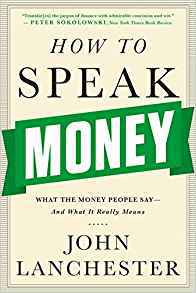
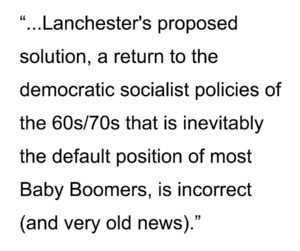 This means Lanchester’s proposed solution, a return to the democratic socialist policies of the 60s/70s that is inevitably the default position of most Baby Boomers, is incorrect (and very old news). As I recall, Reagan/Thatcher never supported the concept of near-monopolies as part of their broader economic strategy, which has, in fact, emerged in modern corporatism of the Western societies over the last 2-3 decades. This suggests that economic model we should be looking towards for a correction in the obvious abuses of the Neo-Liberal economic model (see bank fraud/credit crunch of the Great Recession) lies in the early 20th century ‘trust-busting’ model of Teddy Roosevelt. In this sense, the “Afterwood” serves its purpose by forcing anyone with a basic understanding of history and economics to draw to their own, more rational conclusions in order to reconcile the inherent contradictions of Lanchester’s argument. How to Speak Money: What the money people say… and what they really mean is worth the read but it should be read thoughtfully, not blindly. Grade: 3 1/2 stars
This means Lanchester’s proposed solution, a return to the democratic socialist policies of the 60s/70s that is inevitably the default position of most Baby Boomers, is incorrect (and very old news). As I recall, Reagan/Thatcher never supported the concept of near-monopolies as part of their broader economic strategy, which has, in fact, emerged in modern corporatism of the Western societies over the last 2-3 decades. This suggests that economic model we should be looking towards for a correction in the obvious abuses of the Neo-Liberal economic model (see bank fraud/credit crunch of the Great Recession) lies in the early 20th century ‘trust-busting’ model of Teddy Roosevelt. In this sense, the “Afterwood” serves its purpose by forcing anyone with a basic understanding of history and economics to draw to their own, more rational conclusions in order to reconcile the inherent contradictions of Lanchester’s argument. How to Speak Money: What the money people say… and what they really mean is worth the read but it should be read thoughtfully, not blindly. Grade: 3 1/2 stars


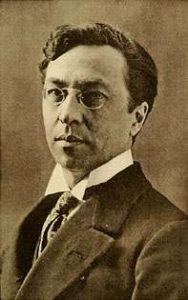 About Wassily Kandinsky
About Wassily Kandinsky
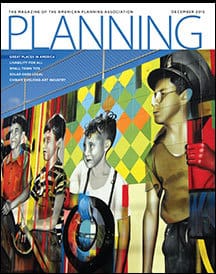 Planning Naked | December 2015
Planning Naked | December 2015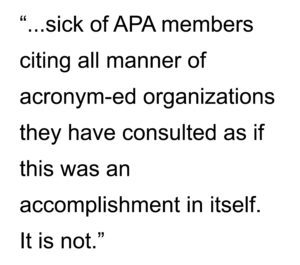 Consultation is an activity (a means to an end) and not an accomplishment in itself. Personally, I’m sick of APA members citing all manner of acronym-ed organizations they have consulted as if this was an accomplishment in itself. It is not. Poor Richard: It isn’t the quantity of the acronyms that matter but the quality of their (letter) characters. APA members need to be careful about flying to something shiny (AARP’s Livability Index, e.g. Won’t someone please think of the old people?!?!) and applying it without thought before understanding its underlying assumptions. Count me suspicious. Based on experience,
Consultation is an activity (a means to an end) and not an accomplishment in itself. Personally, I’m sick of APA members citing all manner of acronym-ed organizations they have consulted as if this was an accomplishment in itself. It is not. Poor Richard: It isn’t the quantity of the acronyms that matter but the quality of their (letter) characters. APA members need to be careful about flying to something shiny (AARP’s Livability Index, e.g. Won’t someone please think of the old people?!?!) and applying it without thought before understanding its underlying assumptions. Count me suspicious. Based on experience, 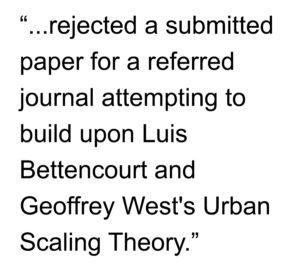 I can’t really comment with authority on the validity of Ewing’s arguments since I have not read the submitted paper in question. Of course, Ewing is correct that the larger the city, the more you have of everything including crime. The aggregated population v. crime correlation is interesting at an abstract level (and should be totally expected) but not very useful for planning policy. For that, you need the sensitive street-by-street and block-by-block modeling techniques of the urban network such as space syntax. In this way, you can demonstrate the usefulness of such correlations between population, crime, location/access, and spatial vulnerability and potential proposed design changes to address the problem. There’s a lot of good research on that front. However, what is refreshing about Ewing’s article is the transparency. It is an excellent attempt to ‘unveil’ the scientific process at work. In this sense, it is very valuable. In fact, Ewing’s article makes me wonder whether there is some inherent value in all referred publications printing short summaries by referees for all rejected papers so that the entire scientific, urban planning community can benefit from seeing the process at work. Something worth thinking about as this could be ‘a rising tide lifts all boats’ type of strategy.
I can’t really comment with authority on the validity of Ewing’s arguments since I have not read the submitted paper in question. Of course, Ewing is correct that the larger the city, the more you have of everything including crime. The aggregated population v. crime correlation is interesting at an abstract level (and should be totally expected) but not very useful for planning policy. For that, you need the sensitive street-by-street and block-by-block modeling techniques of the urban network such as space syntax. In this way, you can demonstrate the usefulness of such correlations between population, crime, location/access, and spatial vulnerability and potential proposed design changes to address the problem. There’s a lot of good research on that front. However, what is refreshing about Ewing’s article is the transparency. It is an excellent attempt to ‘unveil’ the scientific process at work. In this sense, it is very valuable. In fact, Ewing’s article makes me wonder whether there is some inherent value in all referred publications printing short summaries by referees for all rejected papers so that the entire scientific, urban planning community can benefit from seeing the process at work. Something worth thinking about as this could be ‘a rising tide lifts all boats’ type of strategy.